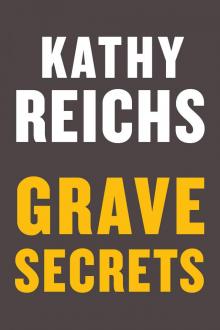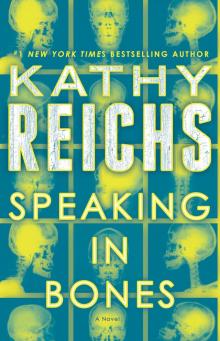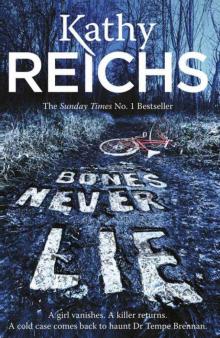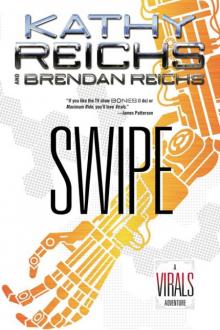- Home
- Kathy Reichs
Flash and Bones Page 9
Flash and Bones Read online
Page 9
“I figure a surprise might liven things up.”
“What does CRRI do?”
“Call me crazy, but I’m guessing they spend a lot of time thinking about lungs.”
Pointedly, I turned my face toward the window.
Corn rows marched to the horizon, dark and shimmery in the afternoon heat. Above them, a red-tailed hawk looped lazy circles low in the sky.
Instead of returning to I-77, Slidell cut west on NC-152. Just before China Grove, he made three right turns, then a left onto a wide paved road.
No cornfields here. Wild flowers as far as the eye could see. A veritable Monet ocean of color.
A quarter mile up the blacktop, redbrick walls stretched to each shoulder, and large iron gates blocked access to manicured grounds beyond. A stone plaque identified the Southeast Regional Research Park.
Slidell stopped at the guardhouse and lowered his window. A uniformed young man emerged with a clipboard. “May I help you?”
“We’re looking for Lynn Nolan.”
“Yes, sir. I’ll check the list.”
“We aren’t on it.”
“I’m sorry, but—”
Slidell held out his badge.
The man studied it earnestly. “Do you have a warrant?”
“Why? Something going on here gonna cause problems?”
“I’ll have to call for clearance.”
“No,” Slidell said. “You won’t. Nolan works for CRRI. Where do I find her?”
“Building Three. Second floor.”
“You have a real special day.” Slidell hit a button and his window hummed up.
The man retreated, the gates opened, and Slidell drove through.
The Southeast Regional Research Park looked like a small college campus in Mississippi. Brick buildings fronted by broad steps, Greco-Roman pillars, porticos, and pediments. Covered parking garages. Well-groomed gardens. Boisterously green grass which seemed to stretch for several hundred acres. Small lake complete with ducks, geese, and a swan.
Yet nothing stirred. The effect was like one of those disaster movies in which a virus destroys life but leaves the hardscape intact.
Building 3 was a four-story number on Progress Avenue. Flanking both sides were half-completed foundations, suggesting progress had been less than desired.
Ignoring the no-parking signs, Slidell pulled to the curb. We got out and entered Building 3 through tinted glass doors.
The lobby was all gleaming rosewood and marble, with a futuristic stone sculpture parked in the center. A directory verified that CRRI was located in 204.
A spotless elevator took us to the second floor. There the decorator’s palette had been labeled something like sand or wheat. Beige walls, beige trim, beige carpet, beige chairs, each shade just a hair off the others. The only color came from framed black and whites with highlighted details. A woman’s red lips. A green umbrella. A blue and yellow tail dangling from a kite.
Room 204 was halfway down on the right.
A woman occupied a desk directly opposite and facing the door. She was tiny, with caramel eyes, sun-bronzed skin, and long brown hair spilling from a barrette atop her head.
When we entered, the woman’s eyes widened. A manicured hand flew to her mouth. “Are you really going to arrest me?”
So much for the guard not announcing our presence.
THE WOMAN WATCHED US CROSS TO THE DESK, HER BODY RIGID with apprehension.
“Lynn Nolan?” Not a bark, but close.
Nolan nodded, lavender-tipped fingers still pressed to her lips. Slidell flipped his badge. “Got some questions about Cindi Gamble.”
Nolan’s eyes now went impossibly wide.
“You remember Cindi Gamble?”
Nolan nodded again.
“You want we should do this standing?”
The hand left Nolan’s mouth and fluttered toward two desk-facing chairs.
As we sat, Nolan’s gaze flicked to me, but she said nothing.
While Slidell started the interview, I looked around.
The furnishings were standard reception-room walnut and tweed, including Nolan’s desk, our chairs, and a love seat centered on the back wall. Fronting the love seat was a coffee table heaped with magazines. Every title contained the terms “air,” “atmosphere,” or “energy.” As in the corridor, beige ruled.
Above Nolan’s head, a mural displayed the CRRI logo, a stylized windmill with greenery twining the central post. Three words circled the blades: GENOMICS. PROTEOMICS. METABOLOMICS.
“You the receptionist?” Slidell produced his spiral, more for effect than note-taking, I suspected.
Another nod.
“What goes on here?”
“Research.”
Slidell stared at Nolan. She stared back.
“Why am I getting the impression you’re not enjoying our visit?”
“Into air pollution.”
By my count, that brought Nolan’s total word count to four.
“Research for who?” Slidell positioned his pen.
“Industrial consortia, clinical trials companies, R and D firms, consulting groups.” The answer sounded rote. Nolan had obviously given the spiel before.
Slidell jotted something, then got to the point.
“You attended A. L. Brown High with Cindi Gamble?”
Nolan nodded again. She was very good at it.
“Tell me about her.”
“Like what?”
“Dig deep, Miss Nolan.”
“It’s Mrs.”
“Uh-huh.”
“I hardly knew her. Like, Cindi wanted to drive race cars. That wasn’t my thing.”
“But you were friends.”
“Just at school. Sometimes we, like, ate lunch together.”
Nolan was gouging a cuticle on one thumb with the acrylic nail on the other. I wondered why a visit from the cops was unnerving her so badly.
“And?” Slidell prodded.
“And then she disappeared.”
“That’s it?”
“We didn’t hang out senior year.”
“Why was that?”
“Like, her boyfriend was a jerk.”
“Cale Lovette.”
Major-league eye roll. “The guy gave me the creeps.”
“Why was that?”
“The whole shaved-head-and-tattoo thing. Gross.”
“That what turned you off? Lovette’s sense of style?”
Vertical lines dented the bridge of Nolan’s nose. Then, “He and his psycho-loser friends were always talking about guns. They thought it was cool to crawl around in the woods and play soldier. I thought it was dumb.”
“That it?”
“They had all these weird ideas.”
“Like what?”
“Like the Japanese blew up that building in Oklahoma. I mean, how dumb is that? Oh, and the United Nations was going to take over the government. There were people, like, setting up concentration camps in national parks.”
“In your statement back in ’ninety-eight, you said you overheard Lovette discussing poison with someone.”
“Another gross-o.”
“Bald and inked?”
“No. Old and hairy.”
“Did you know the guy?”
“No.”
“You stated that Lovette and his buddy were talking about poisoning something.”
Nolan’s eyes dropped to the cuticle. Which was now bleeding. “I could have got it wrong. I wasn’t, like, trying to eavesdrop. But they were pretty—” Nolan circled both hands in the air. “What’s that word for when people, you know, gesture a lot?”
“Animated?” I suggested.
“Yeah. Animated. I passed them when I went to the ladies’.”
“What were they saying?” Slidell.
“Something about poisoning a system. And an ax or something.”
“Where did this conversation take place?”
“A really lame bar up by Lake Norman.”
“Na
me?”
“I don’t remember.”
“Why were you there?”
“Cindi wanted to hook up with Cale, but she knew her parents would flip out, you know, about her being in a bar. She told them there was a school party and talked me into going along to back up the lie. The place was, like, scuzz city.”
“This was a couple of months before Lovette and Gamble went missing.”
“It was summer. That’s all I remember.”
“You think Lovette and his buddies were plotting something illegal?”
“Like robbing a bank?” The caramel eyes were now perfectly round.
“Let’s think here, Lynn. Poison?” Nolan’s dim-wittedness was wearing on Slidell.
“I don’t know. Maybe. Cale was mean as a snake.”
“Tell me about that.”
“Cindi showed up at school one time with bruises on her arms. Like fingerprints, you know?” Nolan was becoming more expressive, using her hands for emphasis. “She never said so, but I think Cale was smacking her around.”
Slidell rotated one hand. Go on.
“Sometimes he talked to her like she was stupid. Cindi wasn’t stupid. She was in STEM. Those people were all, like, scary smart.” A lavender nail jabbed the air. “There’s someone might know more than me. Maddy Padgett. She was in STEM, too. Maddy was totally into cars and engines. I think she and Cindi were tight.”
Slidell scribbled a note. Then, “Why’d Gamble put up with Lovette treating her like crap?”
“She loved him.” As though the question confused her.
“You think she went off with him?”
“Huh-uh.”
“What’s your take?”
Nolan looked from Slidell to me, then back. Her response was delivered with breathy affect. “I think Cale killed her, then ran away.”
Humid air pressed our skin as Slidell and I walked back to the Taurus. The sun was a silver-white disc in the sky. An anemic breeze carried the smell of hot brick and mowed grass.
“Brain power of a newt.”
I suspected Slidell was underestimating the amphibian. Didn’t say so.
“What was that shit above her head?”
I wasn’t sure if he meant Nolan’s updo or the logo. I went with the latter. “Genomics is the study of the genomes of organisms.”
“Like figuring out their DNA?”
“Yes. Proteomics is the study of proteins. Metabolomics is the study of cellular processes.” Oversimplified but close enough.
“How’s all that fit in with air pollution?”
“I’ll Google CRRI.”
Slidell and I got into the car. The heat was worthy of Death Valley.
“What do you think of Nolan’s theory?” I asked after securing my belt.
“That Lovette killed Gamble? The thought crossed my mind.”
“Really?”
Slidell didn’t elaborate until he’d turned the key, maxed the air-conditioning, and unwrapped and popped a stick of Juicy Fruit into his mouth.
“In his notes, Eddie mentions a guy name of Owen Poteat.” Slidell made a U-ey toward the main drag. “Back in ’ninety-eight, Poteat claimed he saw Lovette at the Charlotte airport on the twenty-fourth of October.”
The implication was clear.
“That was ten days after Lovette and Gamble disappeared from the Speedway. How did Poteat know it was Lovette?”
“He’d seen a photo on a flyer. Said the tats and bald head caught his attention.”
“Was Poteat considered credible?”
“The task force thought so. According to Eddie, Poteat’s statement played heavy into the conclusion that Lovette and Gamble took off.”
“What about Cindi?” I asked.
“What about her?”
“Did Poteat see her at the airport with Lovette?”
“Apparently he wasn’t so sure. But here’s the thing.”
Slidell flipped a wave at the guard as we exited the gates. The young man watched us roll through but didn’t wave back.
“At the back of the notebook, Eddie had a page marked with big question marks.”
“Meaning?”
“Meaning he had questions.” Slidell reached out and smacked the AC control with the heel of one hand.
Easy, Brennan.
“Questions about Poteat?” I asked oh-so-precisely.
“Who the hell knows? For that entry, he used one of his codes. Means nothing to me.” Slidell yanked his spiral from a shirt pocket and tossed it to me. “I copied the stuff into there.”
ME/SC 2X13G-529 OTP FU
Wi-Fr 6–8
When hurried or feeling the need for discretion, Rinaldi used a form of shorthand known only to him. The cryptic notations were typical.
“Maine and South Carolina?” I guessed, looking at the longer entry.
Slidell shrugged.
I played with the alphanumeric combo. “Could it be a license plate?”
“I’ll run it.”
“FU probably means follow up.”
I played some more. Came up blank.
“Can I have this?”
“Yeah, sure.”
I tore the page free and slipped it into my purse. Then, “Who is Owen Poteat?”
“I’ll know soon.”
I settled back and closed my eyes. The heat and the car’s motion acted like drugs. I was dropping off when my mobile sounded.
Joe Hawkins.
I clicked on.
“Hey, Joe.” Sluggish.
“Forensics called with a prelim on the goop from the barrel. Good old asphalt, just like we thought.”
“Not very useful.”
“Maybe no, maybe yes. The sample contained an additive called Rosphalt, a synthetic dry-mix material made by Royston. Provides waterproofing, skid resistance, protects against rutting and shoving, thermal fatigue cracking, that kind of thing. ”
“Uh-huh.” Stifling a yawn.
“Rosphalt comes in three types. One’s used mainly for roadways and tunnels, another’s used on airport runways. You still there?”
“I’m here.” Though struggling to stay awake.
“Your sample contained the third type, R50/Rx. That one’s used mostly by motor speedways.”
My brain reengaged. “At the Charlotte Motor Speedway?”
“Knew you’d ask, so I gave a call out there. The track has some pretty steep banking. What with the sun and cars screaming around the curves, the asphalt can heat up, go liquid, and sink right down. They use Rosphalt to provide better holding power.”
“I’ll be damned. So the asphalt in the barrel probably came from the Speedway.”
“Seems logical to me. The track’s right there.”
“Thanks, Joe.”
I disconnected and told Slidell. “The Rosphalt connects the landfill John Doe to the track.” I was totally pumped.
“Whaddya saying? The victim was killed at the Speedway, stuffed in a barrel, sealed in, and dumped at the landfill?”
“Why not? Thirty-five-gallon oil cans are common at speed-ways.”
While Slidell was gnawing on that theory, my phone sounded again. This time it was Larabee.
“These assholes have gone too far!”
“Which assholes?”
“They won’t get away with this.”
“Get away with what?”
“The goddamn FBI torched our John Doe!”
THE BUZZING IN MY PHONE WAS SO AGITATED THAT SLIDELL kept glancing my way. Again and again I gestured his eyes back to the road.
Peppered with expletives, the story came out.
Through multiple calls, many threats, and the intervention of the chief ME in Chapel Hill, Larabee had finally pried loose information on the whereabouts of MCME 227-11. Since the presence of ricin suggested the possibility of bioterrorism, the landfill John Doe had been confiscated under a provision of the Patriot Act and taken to a lab in Atlanta. There the body had been re-autopsied and new samples collected.
Far
from standard protocol but understandable.
Then the bombshell.
Due to an unfortunate combination of circumstances, including a mix-up in paperwork, understaffing, and an error on the part of an inexperienced tech, instead of back to the cooler, the landfill John Doe had accidentally been sent for cremation.
Larabee was livid. Before disconnecting, he threatened complaints to the governor, the Department of Justice, the director of the FBI, the secretary of Homeland Security, the White House, maybe the pope.
I decided it was a bad time to mention the Rosphalt.
As Slidell maneuvered through rush-hour traffic, I told him about the fate of the John Doe.
“That smell right to you?” I asked.
“As right as a barrel of week-old fish.”
Slidell said nothing further until we were parked beside my car at the MCME. Then he grasped the wheel and rotated toward me. “What’s your take, Doc?”
I ticked off points on my fingers.
“A couple vanishes in 1998. Family and associates disagree with a task force finding that the two left voluntarily. The missing couple has ties to and is last seen at a motor speedway. Years later a body turns up in a barrel of asphalt. That barrel is discovered in a landfill adjacent to said speedway, in a sector and layer dating from the late nineties to 2005.”
I moved to my other hand.
“The asphalt in the barrel contains an additive commonly used at speedways. An autopsy finds that the body is contaminated with ricin, a poison once favored by anti-government extremists. The male member of the missing couple belonged to a right-wing militia. When the ricin is reported to the FBI, the body is confiscated and destroyed.”
Slidell was silent for so long, I was certain he was about to blow me off. He didn’t.
“You’re thinking the landfill John Doe is connected to the Gamble-Lovette disappearance?”
I nodded.
“How?”
“I don’t know.”
“Who was the stiff?”
“I don’t know.”
“Lovette?”
“The age indicators are off, but I can’t rule him out.”
“What about this guy Raines from Atlanta?”
“The barrel looked way too old. And the sector it came from doesn’t fit with a recent body dump.”
“But your voice is telling me you can’t rule him out, either.”
“No. I can’t.”
Again Slidell went quiet. Then, “Maybe Cindi Gamble’s baby brother isn’t crackers after all.”

 Two Nights
Two Nights The Bone Collection: Four Novellas
The Bone Collection: Four Novellas Fatal Voyage
Fatal Voyage 206 Bones
206 Bones Bones to Ashes
Bones to Ashes Terminal
Terminal Monday Mourning
Monday Mourning Flash and Bones
Flash and Bones Cross Bones
Cross Bones Devil Bones
Devil Bones Break No Bones
Break No Bones Swamp Bones
Swamp Bones Déjà Dead
Déjà Dead Shock
Shock Spider Bones
Spider Bones Death Du Jour
Death Du Jour Grave Secrets
Grave Secrets Trace Evidence: A Virals Short Story Collection
Trace Evidence: A Virals Short Story Collection Bones on Ice
Bones on Ice The Bone Code
The Bone Code Bones in Her Pocket
Bones in Her Pocket Seizure:
Seizure: Speaking in Bones
Speaking in Bones Deadly Decisions
Deadly Decisions Spike
Spike Bones Never Lie
Bones Never Lie Bones of the Lost
Bones of the Lost Virals 03.5 - Swipe
Virals 03.5 - Swipe Exposure
Exposure A Conspiracy of Bones
A Conspiracy of Bones Shift (tory brennan)
Shift (tory brennan) Bones of the Lost: A Temperance Brennan Novel tb-16
Bones of the Lost: A Temperance Brennan Novel tb-16 Virals tb-1
Virals tb-1 Bones Are Forever tb-15
Bones Are Forever tb-15 Code tb-3
Code tb-3 Seizure tb-2
Seizure tb-2 Deadly Descisions
Deadly Descisions Spider Bones: A Novel
Spider Bones: A Novel